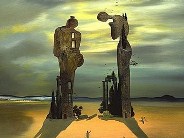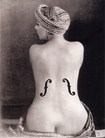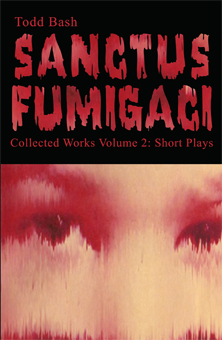

CHRONOLOGY OF SURREALISM
1916
While recuperating from a shrapnel wound in a military hospital, Jacques Vaché meets André Breton, then a medical student. The two become close friends and continue a correspondence after Vaché's return to the front lines.
1917
Breton meets Louis Aragon, also a medical student, and Philippe Soupault.
Guillaume Apollinaire coins the term "surrealism", using it to describe his play The Breasts of Tirésias.
1919
Breton, Aragon and Soupault unite in Paris and begin publishing the avant-garde periodical Littérature. Before his planned arrival, Vaché dies from an opium overdose.
Breton and Soupault experiment with automatic writing, dedicating their first collection, The Magnetic Fields, to the memory of Jacques Vaché.
Breton corresponds with Dadaists, including Tristan Tzara, who arrives in Paris later that year.
1920
Along with Tristan Tzara, Jean Arp and Francis Picabia, the Littérature group participates in numerous Dada activities.
1921
Breton visits Sigmund Freud in Vienna.
1922
Having splintered from the traditional Dadaists, the Littérature group, now calling themselves Surrealists, includes Breton, Aragon, Soupault, Benjamin Péret, Paul Eluard, Max Ernst, Man Ray, Robert Desnos, Jacques Baron, René Crevel, Georges Limbour, Jacques Rigaut and Roger Vitrac, among others. Marcel Duchamp also periodically participates in the group's activities.
"Sleep experiments" are conducted, examining an individual's verbal and artistic responses while under hypnosis. Desnos and Crevel emerge as the most gifted participants in these investigations.
1923
Artists André Masson and Yves Tanguy join the Surrealists. Masson experiments with automatic drawings.
1924
Breton publishes the First Manifesto of Surrealism, along with his collection of automatic writing, Soluble Fish. Aragon's The Libertine and Vaché's Letters From the Front (written to Breton during World War I) are also published.
After five years (1919-24), the publication of Littérature comes to an end, as the group launches a new periodical, La Révolution Surréaliste. A Bureau of Surrealist Enquires is opened in Paris.
Antonin Artaud, Joan Miró, Raymond Queneau, Max Morise, Pierre Naville, Jacques-André Boiffard and Georges Malkine join the Surrealist group. Giorgio de Chirico also periodically participates in the group's activities.
Miró paints The Hunter and Harlequin's Carnival, while Ernst paints Woman, Old Man and Flower and Two Children Are Threatened by a Nightingale.
A Surrealist group in Yugoslavia forms under the leadership of Marco Ristitch.
1925
Michel Leiris, Jacques Prévert, Pierre Brasseur and Marcel Duhamel join the Surrealist group. Desnos writes Mourning For Mourning, a collection of automatic writing. Artaud writes Umbilical Limbo.
The Surrealists present their first group art exhibit at Galerie Pierre in Paris.
Ernst develops "frottage," a creative approach that involves drawing (or rubbing) over a textured surface, producing unusual and automatic patterns. His painting The Horde (1927) utilizes this technique.
1926
Le Cadavre Exquis (The Exquisite Corpse), an artistic game that emphasizes spontaneity and collaboration, is invented by the group.
Man Ray directs the surrealist film Emak Bakia. Surrealist publications include Aragon's Paris Peasant, Artaud's Nerve Scales, Eluard's Capital of Pain and Desnos' A la mystérieuse.
A Surrealist group in Belgium forms, featuring the participation of Camille Goemans, Marcel Lecomte, René Magritte, Paul Nougé and E.L.T. Mesens.
Pablo Picasso takes part in some of the Surrealists' activities, though he never officially joins the group.
1927
André Breton has his first flirtation with the Communist Party. Artaud, Vitrac and Soupault are expelled from the group. Soon after, Artaud and Vitrac form the Alfred Jarry Theater, where Artuad begins developing his thoughts concerning a Theater of Cruelty. The company opens with a production of Vitrac's play The Secrets of Love.
Desnos writes his masterpiece Liberty or Love. Other Surrealist literature includes Leiris' The Cardinal Point and Aragon's Irene's Cunt.
A Surrealist Gallery is opened in Paris.
1928
Un Chein Andalou, a surrealist film by Luis Buñuel and Salvador Dalí, is screened for the first time. Shortly after, the two Spainards join Breton and his group. L'Étoile de Mer, a film directed by Man Ray and scripted by Robert Desnos, is also premiered.
Several important Surrealist works are written, including Breton's Nadja, Leiris' Aurora, Aragon's Treatise on Style, Péret's Mad Balls and Desnos' play La Place De La' Étoile.
A series of round table discussions are held by the Surrealists, exploring the nature of sex. They continue, sporadically, until 1932.
An uneasy alliance develops between the Surrealists and the group Le Grand Jeu, featuring René Daumal, Roger Gilbert-Lecomte, Maurice Henry, Joseph Sima, Arthur Harfaux and Roger Vaillant.
The Alfred Jarry Theater presents an experimental production of Strindberg's A Dream Play, directed by Artaud. Six months later, Vitrac's Victor, or The Children Are In Power is staged.
Magritte paints The False Mirror, Titanic Days and The Lovers.
1929
A number of Surrealists join the Communist Party.
Prévert, Baron, Desnos, Leiris, Limbour, Masson, Queneau, Morise and Boiffard are expelled from the group. Several go on to collaborate with Georges Bataille on his periodical Documents.
Buñuel, Dalí, Alberto Giacometti, Rene Char and Lee Miller join the Surrealists. Tristan Tzara reconciles with Breton.
Breton writes his Second Manifesto of Surrealism, which addresses the expulsions of several ex-members.
After five years (1924-29), the publication of La Révolution Surréaliste comes to an end, as the group begins preparing a new, more politically-driven periodical Le Surréalisme au service de la révolution.
Surrealist writings include Benjamin Péret's Death to the Pigs and Giorgio de Chirico's Hebdemeros.
Dalí paints The Lugubrious Game and The Great Masturbator.
Federico García Lorca studies at Columbia University in New York City. Influenced by his close friends Buñuel and Dalí, he begins a collection of surrealist poetry, Poet in New York, as well as a surrealist film script, Trip to the Moon.
Jacques Rigaut commits suicide.
1930
The first issue of Le Surréalisme au service de la révolution is published.
Several ex-surrealists, including Desnos, Limbour, Baron, Vitrac and Queneau, sign an anti-Breton pamphlet Un Cadavre.
L'Age d'or, a surrealist film by Buñuel (co-written with Dalí) is screened, causing a riot. Several paintings by surrealist artists, which had been exhibited in the lobby of the theater, are destroyed.
Breton and his circle begin creating surrealist objects. Tzara completes his epic poem Approximate Man, while Breton and Eluard collaborate on The Immaculate Conception.
1931
Countless surrealist objects are created.
The Surrealists join the Association des Ecrivains et Artistes Revolutionnaires (The Association of Revolutionary Writers and Artists).
Dalí paints The Persistence of Memory. Breton writes Free Union, perhaps his most famous poem.
1932
Aragon and Georges Sadoul sever ties with the Surrealists, committing themselves fully to Communism.
Meret Oppenheim, Victor Brauner, Arthur Harfaux, Maurice Henry, Georges Hugnet, Marcel Jean and Gui Rosey, among others, join the Surrealists.
Breton writes Communicating Vessels.
1933
Breton is expelled fromThe Association of Revolutionary Writers and Artists for "refusing to submit to the discipline of self-criticism."
The final issue of Le Surréalisme au service de la révolution is published. Breton takes part in the publication of Minotaure, a glossy magizine, which soon includes the contributions of numerous surrealists.
The group gives a show at the Salon des Surindependants, with artist Wassily Kandinsky as their guest of honor.
1934
Oscar Dominguez, Dora Maar, Richard Oelze, Gisele Prassinos and Brion Gysin join the Surrealists.
A Surrealist group forms in Czechoslovakia, featuring the participation of Vitezlav Nezval, Jindrich Štyrský, Karel Teige and Toyen.
Dalí paints Atavistic Vestiges After the Rain and Mae West's Face Which May Be Used as a Surrealist Apartment.
1935
Wolfgang Paalen and Hanns Bellmer join the Surrealists. Bellmer begins creating a series of startling objects, photographs and drawings, which he titles The Doll. The artist continues exploring this theme for several years to come.
The first Bulletin International du Surréalisme is published in Prague, followed by the second Bulletin International du Surréalisme in Brussels.
The Surrealists take part in the "Contre-Attaque" movement, an anti-facist "Fighting Union of Revolutionary Intellectuals."
René Crevel commits suicide.
1936
An exhibit of Surrealist Objects is held at the Galerie Ch. Ratton in Paris.
The first international Surrealist exhibition is held in London, featuring the participation of several British Surrealists, including David Gascoyne, Humphrey Jennings, Henry Moore, Hugh Skys Davies, Eileen Agar, Paul Nash and Herbert Read. The third Bulletin International du Surréalisme is published.
A Surrealist newspaper is developed in Tokyo, Japan, under the direction of Yamanaka.
Dalí appears on the cover of Time magazine. Lorca is shot to death by a Spanish nationalist.
1937
Breton's Mad Love is published.
Artaud is interned in a mental hospital.
1938
The second international Surrealist exhibition is held at the Galerie des Beaux-Arts in Paris. Belgian artist Paul Delvaux, who has created several dream-like paintings, takes part in the show. A third exhibit is held in Amsterdam.
Matta joins the Surrealists, while Eluard breaks with the group, devoting himself to Communism.
Breton visits Mexico, meeting Leon Trotsky, Diego Rivera and Frida Kahlo during his stay. He collaborates with Trotsky on the manifesto Towards a Free Revolutionary Art.
1939
Dalí creates the Dream of Venus Surrealist Funhouse at the World's Fair in New York. Other Surrealists travel to the United States, including Tanguy and Matta, while Wolfgang Paalen goes to Mexico.
Angered by Dalí's self-promotion and commercialism, Breton creates the anagram "Avida Dollars" for the artist.
1940
An international Surrealist exhibition is held in Mexico.
Wifredo Lam joins the group.
Germany invades France, causing many of the Surrealists to disperse. Some make their way to the United States, while others remain in the country, fighting for the resistance.
1942
An international Surrealist exhibition is held in New York. During their stay in the city, Breton, Duchamp and Ernst publish the periodical VVV. Dorothea Tanning, David Hare and Patrick Waldberg join the exiled Surrealists.
A surrealist magazine, Dyn, appears in Mexico.
Dalí's autobiographical book The Secret Life of Salvador Dalí is published.
1943
In Brussels, Nouge publishes Rene Magritte ou les Images defendues.
Gilbert-Lecomte dies at the age of 36.
Desnos is arrested in France and is ultimately sent to a concentration camp, where he dies two years later.
1944
Breton meets Arshile Gorky and highly praises the artist's work.
René Daumal dies. Like his close friend and colleague Gilbert-Lecomte, he is only 36.
Dalí's novel Hidden Faces is published.
1945
In Mexico, Péret publishes Deshonneur des poetes, a pamphlet against the patriotic poems of Aragon and Eluard, which were being distributed by the underground movement in France during the German occupation.
Dalí designs the dream sequence for Alfred Hitchcock's film Spellbound.
1946
Breton returns to Paris. Artuad is released from a mental hospital.
1947
An international Surrealist exhibition is held at the Galerie Maeght in Paris.
Breton protests a lecture given by Tristan Tzara, in which the former Dadaist criticizes Surrealism.
Breton's Arcanum 17 is published.
Artaud gives lectures in Paris and writes a radio play, To Have Done With The Judgment Of god.
1948
Péret returns to Paris.
International Surrealist exhibitions are held in Prague and Santiago, Chile.
An anti-religion collective manifesto, A la niche, les glapisseurs de dieu, is published, signed by fifty-two Surrealists, including fifteen from the pre-War group.
Dalí begins a series of innovative photographs with Phillippe Halsman, including Dalí Atomicus and Nude With Popcorn.
Artaud's To Have Done With The Judgment Of god is shelved by French Radio the day before it is scheduled to air, on February 2, 1948. Artaud dies one month later.
Arshile Gorky commits suicide.
1949
J. Caceres, leader of the Surrealist group in Chile, dies.
Péret completes The Elegant Ewe, an automatically written book he began during the 1920s.
1950
Luis Buñuel reemerges as a prominent film maker with the release of Los Olvidados, shot in Mexico. While the film is done in the spirit of neorealism, it does contain a memorable dream sequence.
1951
In protest against the inclusion of Michel Carrouges, a practicing Catholic, in the Surrealist movement, several members leave the group, including Jacques Harold, Maurice Henry, Marcel Jean and Patrick Waldberg.
Dalí and Phillippe Halsman create the photograph The Skull.
Roger Vitrac dies.
1952
Wolfgang Paalen returns to Paris.
Surrealists work on Libertaire, a newspaper of the Anarchist Federation. An exhibition of Surrealist art is presented in Saarbrucken.
Buñuel directs the film El in Mexico.
Paul Eluard dies.
1953
Tanguy is expelled by the Surrealists.
1954
Dalí and Phillippe Halsman publish the book of photographs Dalí's Mustache.
Francis Picabia dies.
1955
Buñuel directs the film The Criminal Life of Archimboldo de la Cruz in Mexico.
Tanguy dies.
1956
Le Surréalisme, Même, a post-War Surrealist periodical, is published in Paris. Edited by Breton, under the direction of Jean Schuster, three issues appear over the next two years. Among the many contributors are Péret, Duchamp, Toyen, Leonora Carrington, Man Ray, E.L.T. Mesens, Jindrich Styrský, Jean-Claude Silbermann and Meret Oppenheim.
1958
Bief, a follow-up to Le Surréalisme, Même, is published. Featuring political articles that reflect the Surrealist group's attitudes concerning the French/Algerian War, as well as literary and art criticism, eleven issues appear over the next two years. Contributors include Breton, Péret, Gérard Legrand, Jean Schuster, Jean Robert Benayoun, Jean-Claude Silbermann and Jose Pierre, among others.
Péret's Natural History is published.
Oscar Dominguez commits suicide.
1959
Péret dies. Paalen commits suicide.
1960
An international Surrealist exhibition is held at the Galerie D. Cordier in Paris.
Breton and his followers protest Marcel Duchamp's decision to accept a painting by Dalí at an international Surrealist exhibition in New York.
1961
La Brèche, the last Surrealist periodical to feature the participation of André Breton, is published. Featuring articles on art, politics, psychology and Surrealism, eight issues are published over the next four years.
Buñuel directs Viridiana in Spain.
1962
Buñuel directs The Exterminating Angel in Mexico.
1963
Tristan Tzara dies.
1964
A major surrealist exhibition is held in Paris. Breton protests, because he was not asked to organize the exhibit.
Dalí's Diary of a Genius is published.
1965
Buñuel directs Simon of the Desert in Mexico.
A major exhibition of Richard Oelze's paintings tours Germany.
1966
André Breton dies.
(Over the past forty years, while various groups of surrealists have continued to appear throughout the world, in the eyes of many, Surrealism, as an organized movement, ended with the death of Breton.)
1967
Buñuel directs Belle de Jour in Paris.
Rene Magritte and Paul Nougé die.
1968
Dalí's Open Letter to Salvador Dalí is published.
Marcel Duchamp dies.
1969
An Autobiography of Surrealism, which features a series of interviews with André Breton, is published.
Buñuel directs The Milky Way
1970
Soft Cell Portrait, a documentary about Dalí, is released. The film is narrated by Orson Welles.
1972
Buñuel's film The Discreet Charm of the Bourgeoisie wins the Academy Award for Best Foreign Film.
1973
The Unspeakable Confessions of Salvador Dalí, a book of "confessions" as told to Andre Parinaud, is published.
1974
The Dalí Theater Museum in Figueres opens. Buñuel directs The Phantom of Liberty.
1975
Hans Bellmer dies.
1976
Max Ernst and Raymond Queneau die.
1977
Man Ray dies.
1983
Buñuel writes his autobiography My Last Sigh. He dies a few months later.
Joan Miró dies.
1989
Salvador Dalí dies.
1990
Michel Leiris dies.
1994
Paul Delvaux dies.
2003
The library, art work and other historical treasures that were part of André Breton's apartment on 42 Rue Fontaine in Paris, are sadly auctioned off, dispersing the legacy of the Surrealist Movement. Among the items are more than 500 sheets of paper noting down the utterances emanating from the sessions of hypnotic sleep in 1922, as well as a 1924 copy of the Surrealist Manifesto, signed by Breton, Paul Eluard and Louis Aragon. An original 1928 edition of Nadja is also included, along with letters from the Nadja, whom Breton had fallen in love with two years earlier.
2008
The original Surrealist Manifesto by André Breton is auctioned off in Paris, selling, along with several other documents, for 3.2 million Euros (more than 5 million dollars). The work is now displayed in the privately-owned Museum of Letters and Manuscripts in Paris.
All of the biographies and book lists found on this site, as well as texts found on the HOME, HISTORY, COMMENTARY & PERIODICALS pages, are the sole property of Surrealism-Plays.com.
